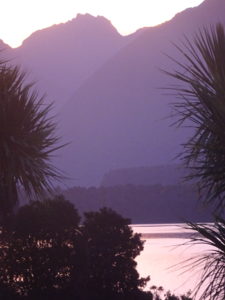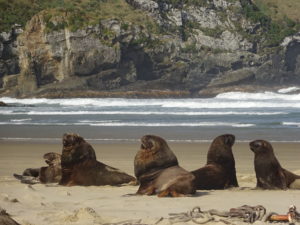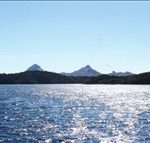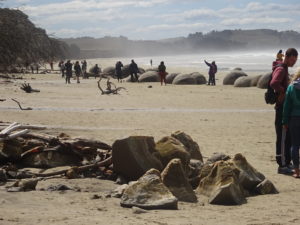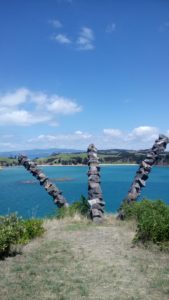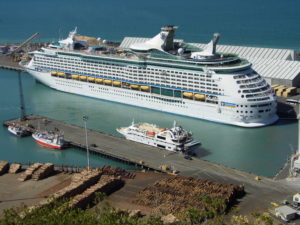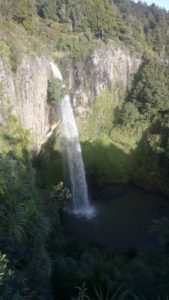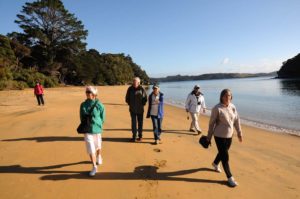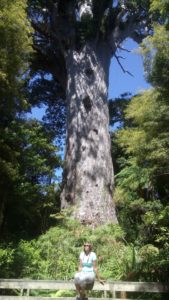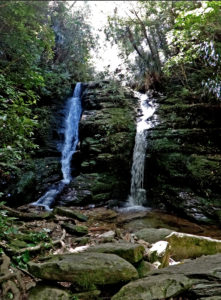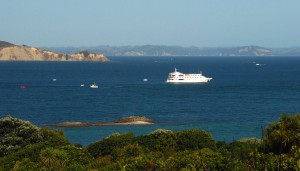Posts Tagged ‘sustainability’
NZx: April 30th – an (un) certain future?
Naumai
Our environment is changing there can be no doubt. Whether this is due to factors such as human interference, over fishing, climate change, or a combination, many species in NZ face an (un) certain future.
In this blog we explore an (un) certain future for New Zealand sea lions or whakahao/rāpoka. You can out more about these remarkable mammals here and here.
My first encounter with New Zealand sea lions was deep in the myriad of waterways that make up Port Pegasus on Rakiura/Stewart Island. We had seen the sleek creamy brown outline of females in the water as we made our approach to land. Stepping ashore we began to wander through the primeval forest until suddenly a large brown male stood up on it’s hind flippers and roared at us from behind a prostrate rata tree. This was a truly remarkable NZx experience!
Since then I’ve been lucky enough to encounter both sexes on many parts of southern mainland New Zealand and other areas of Rakiura/Stewart Island. A recent journey to Dunedin and the Catlins led to further encounters with a variety of New Zealand sea lions. It is always intriguing when encountering threatened wildlife, that so many of the visitors in these “off the beaten track” places are from overseas. Don’t we as New Zealander’s value what we have?
On a parallel path the potential loss of the Hoiho from mainland New Zealand within a few decades is another indication of how fragile our environment is. You can find more about Hoiho here and here. Despite this bleak lookout for such an iconic species, advocacy around the issue and more importantly potential action, is frustratingly slow and deafeningly quiet.
Where does that leave New Zealand sea lions (whakahao/rāpoka) and their future as an iconic New Zealand species? We have previously commented on the wider issue of economic development and lack of input from tourism operators and environmental interests when it comes to New Zealand sea lions – see our March 2017 blogspot .
Much of our tourism product is based around the broader environment, without a coordinated approach to managing what we have, tourism itself is at risk.
How can we promote ourselves to the world as an environmentally sensitive country, that cares for our taonga, when so much of what makes this country special faces an (un) certain future?
Ka kite ano
NZx: February 10th Manaakitanga in the C21
Naumai
Is this really the best manaakitanga we can offer?
Tourism New Zealand suggests: the meaning of manaakitanga is much broader than a one word or direct translation.
It can be broken down into three parts: mana-ā-ki which loosely translates as ‘the power of the word’ and reminds hosts to be expressive and fluent in welcoming visitors.
Another explanation has the words mana / prestige and ki te tangata / to the people – pointing out the importance of enhancing the mana which covers the integrity, status / prestige, and power of guests.
Here, as our experience suggests, a great day out was left wanting in manaakitanga by our introduction to Fullers ferry and the introduction by staff on arrival at Rotoroa Island.
Our manaakitanga component started off by having to queue for the ferry. No big deal but despite being early morning it was a burning , windless day. People who had queued early inside the perspex cover were eventually forced to abandon their place in line and escape the hot tapped air. It was seriously stifling.
There was general confusion about who was queuing for what. Was this the ferry to Rangitoto, Tiritiri Matangi or Rotoroa Island? No signs, or technology, not even temporary, just two staff that came and went answering the same questions as to the destination.
Two minutes after leaving the wharf we returned – someone had got on the wrong ferry……. That’s despite a handheld scanner that supposedly scanned everybody aboard including our mobile phone downloaded tickets. Only problem was it couldn’t read the bar code on our phone!
On arrival all seventy plus of us were crammed into a small hot shed on the wharf and given a rambling presentation about the history, issues and do’s and dont’s on the Island. We fully support the bio-security intent behind this – but having endured countless windblown ( you can’t here the words and often the speakers aren’t great) welcomes at Tiritiri Matangi and other DOC/partner managed islands, one has to wonder is there a better way? It is human nature to not what to be confined (see Maslow) and to be acknowledged and treated with intelligence. This and other Island welcomes don’t do this! DOC and it’s partners should use other ways of pushing the bio-security message to what is mostly an already knowledgeable audience.
The final straw was when the ranger announced a different ferry departure time back to Auckland than that advertised in the various Fullers media. Normally extra time on an Island such as Rotoroa would be great, but we had organised a busy late afternoon around the quoted departure time and arrival back in Auckland.
The last comment the ranger made before “releasing us” was to invite us back inside the shed before we got on the return ferry – surely not!
In the end it was with much thankfulness that the staff on Rotoroa didn’t invite us back into the hot little shed on the wharf to say haere ra! Everyone was far too busy enjoying the sunshine, swimming off the wharf an enjoying their last minutes on the Island.
Rotoroa Island is a fantastic day out. But two of the key partners need to up their game in the manaakitanga stakes. The basic mana of visitors just isn’t being respected.
Ka kite ano
NZx March 25th: the pace of change
Naumai
There is no doubt that the pace of change in New Zealand tourism is continuing to grow: everywhere you look there are more visitors out there experiencing what NZ has to offer. A recent trip to the West Coast confirmed that. Even a site like Oparara http://www.karameainfo.co.nz/oparara-basin/ was very busy.
Some of the tourism issues have or are being well debated. Issues such as freshwater, overcrowding at key sites, climate change and visitor levy’s are all part of the current “conversation”.
On a broader level, but very closely aligned with increasing tourism, a number of issues were highlighted last year by Jan Wright, Commissioner for the Environment. Wright raised four key issues: climate change, slow progress in marine protection, lack of trees on unstable hill country, and concerns over the future of our wildlife.
She made the interesting point that environmental issues, rather than separate domains (air, land, marine, climate and fresh water), should form the basis of the shared story. This more holistic approach makes common sense.
Wright’s comments reflect the split in the key debates, and lack of an holistic approach, being canvassed over NZ tourism, the environment and business.
Mayor Goff’s accommodation tax being one such initiative.
A wider, holstic example is the recent study identifying Rakiura’s Port Pegasus for a potential new salmon farming enterprise http://www.stuff.co.nz/southland-times/news/90883538/Stewart-Island-chosen-for-possible-new-aquaculture-project . This central-government funded programme involves Ngai Tahu, the Department of Conservation, the Ministry for the Environment, the Ministry of Primary Industries and the Ministry of Business, Innovation and Employment. Sorry – where is tourism in that mix? Its unbelievable that tourism opportunities are currently heavily restricted in Pegasus yet an industry with doubtful environmental credentials is being supported.
NZ tourism is entering a sensitive phase, particularly in regard to the potential effects on local communities of such growth and the shutting out of potential added value tourism opportunities.
Ka kite ano
Malcolm
NZx January 27th: Northland / Te Tai Tokerau
Naumai
Northland /Te Tai Tokerau is a fantastic place. There are many icons to visit here; Tane Mahuta, Russell, Waitangi, Cape Reinga or any beach with golden sands, pohutakawa and sparking blue sea.
A recent visit to Northland enabled us to spend some time exploring both the icons and the back roads.
The icons are all there, service was mostly good but some of the infrastructure was looking decidedly tired and away from the icons – empty. Most of the tourism entities were either staffed by Caucasian or international transients. While hyped up with great marketing the cultural interaction was limited, oversold and didn’t address many of the basics of great visitor experiences.
Beyond the icons it wasn’t to hard to find another story. Hints of elitism, exclusion and then poverty and well… another world one which most New Zealanders aren’t aware of..
It’s sometimes useful to look beyond our initial impressions, and to reflect on how tourism could provide a positive contribution to all in it’s community.
Ka kite ano
NZx October 14th : Crunch summer ahead
Naumai
All the indications are that this will be a crunch summer for tourism in New Zealand.
Reports suggest many accommodation providers are full, attractions run the risk of turning people away and transport providers (particularly rental providers) have invested in new stock.
The likelihood is that international visitors will be here in increasing numbers, particularly in iconic locations. Will that create a problem with New Zealand domestic visitors seeking the relatively uncrowded experience they have been accustomed too?
Ship Cove/Meretoto in Queen Charlotte Sound is a case in point. Easily accessible by scheduled boat services, private vessel and some international cruise ships, the iconic site maybe under threat from sheer numbers this summer. The track (and it certainly isn’t of a great standard) is often quiet but from November to March that changes. At any one time the narrow track can be full of visitors, both domestic and international, throughout the day. At what stage is the visitor experience compromised?
Solutions to this “nice to have” problem are complex. Tourism New Zealand is moving to focus marketing efforts on the shoulder season, the conversation around taxing international visitors is gaining momentum and both traditional media and social media are focusing on the opportunities.
Ka kite ano
NZx 15th November : Cruized
Naumai
One has to “admire” the persistence of the public relations machine that surrounds big ship cruising.
Trumpets sounding the largest cruise ship ever to visit New Zealand arrived in Dunedin yesterday. The constant lobbying of the sector for improved facilities for their clients is paramount. The large cruise ships arrive, spend hours shipping their passengers ashore, spend even longer shipping them away from the local community to some far off attraction, spend hours shipping their passengers back on board, then leave.
In contrast, small ships such as the Oceanic Discoverer (max capacity 72 passengers) are in a different space. Spending 12 nights exploring New Zealand they visit, and stay, in regional ports and in local anchorages. Exploration ships such as these require no facilities: other than a port visit once in the middle and at the beginning and end of their 12 night cruise.
There are no casinos, live shows or in many cases television. The “entertainment” are the guest lecturers or expedition leaders. The subjects: New Zealand inc. They use local operators and often allow passengers to arrange their own evening meal ashore.
They don’t lobby for expensive on-shore facilities where they do stop. All they simply need is a wharf and gangplank.
Surely this is a better long term sustainable outcome for NZ tourism than 5,000 people dumped amongst a bunch of logs miles from a city.
It’s a little like the Chinese market.Quick, get the masses in don’t worry about the long-term sustainability of the sector, or the industry. In fact it is deja-vu. We have all been through this with the Korean market not so long ago.
Think what happened to the large ship cruise market in Alaska. The effects that I have seen with my own eyes on small communities, the environment and the costly facilities built, linger on. Search the web for impacts of large cruise ships…….
The large cruise ship market is fickle. One day New Zealand Inc won’t be flavour of the month.
Ka kite ano
Malcolm
